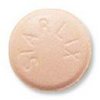
STARLIX INDICATIONS
Starlix (nateglinide) is an oral diabetes medicine that helps control blood sugar levels. Starlix helps your body respond better to insulin produced by your pancreas.
Starlix is used together with diet and exercise to treat type 2 diabetes. Other diabetes medicines are sometimes used in combination with nateglinide if needed.
It may also be used for purposes not listed in this medication guide.
STARLIX INSTRUCTIONS
Take Starlix exactly as prescribed by your doctor. Do not take in larger or smaller amounts or for longer than recommended. Follow the directions on your prescription label.
Starlix is usually taken 3 times daily, within 30 minutes before eating a meal. Follow your doctor's instructions. If you skip a meal, do not take your dose of Starlix. Wait until your next meal.
Your blood sugar will need to be checked often, and you may need other blood tests at your doctor's office. Visit your doctor regularly.
Know the signs of low blood sugar (hypoglycemia) and how to recognize them: headache, hunger, weakness, sweating, tremor, irritability, or trouble concentrating.
Always keep a source of sugar available in case you have symptoms of low blood sugar. Sugar sources include orange juice, glucose gel, candy, or milk. If you have severe hypoglycemia and cannot eat or drink, use an injection of glucagon. Your doctor can give you a prescription for a glucagon emergency injection kit and tell you how to give the injection.
Check your blood sugar carefully during a time of stress or illness, if you travel, exercise more than usual, drink alcohol, or skip meals. These things can affect your glucose levels and your dose needs may also change.
Your doctor may want you to stop taking Starlix for a short time if you become ill, have a fever or infection, or if you have surgery or a medical emergency.
Ask your doctor how to adjust your Starlix dose if needed. Do not change your medication dose or schedule without your doctor's advice.
Starlix is only part of a complete program of treatment that also includes diet, exercise, and weight control. Follow your diet, medication, and exercise routines very closely. Changing any of these factors can affect your blood sugar levels.
Use Starlix regularly to get the most benefit. Get your prescription refilled before you run out of medicine completely.
STARLIX STORAGE
Starlix is usually taken 3 times daily, within 30 minutes before eating a meal. Follow your doctor's instructions.
STARLIX STORAGE
Store Starlix at room temperature away from moisture and heat.
STARLIX MORE INFO:
Active Ingredient: Nateglinide
Starlix is an antidiabetic agent. It works by lowering blood glucose levels, causing insulin to be released from beta cells of the pancreas.
Do NOT use Starlix if:
you are allergic to any ingredient in Starlix
you have type 1 diabetes
you have diabetic ketoacidosis
if you are pregnant, planning to become pregnant, or are breast-feeding
if you are taking any prescription or nonprescription medicine, herbal preparation, or dietary supplement
if you have allergies to medicines, foods, or other substances
if you have adrenocortical, pituitary, liver, or kidney problems
if you have a high fever or are malnourished
Beta-adrenergic blockers (eg, metoprolol), gemfibrozil, imidazoles (eg, ketoconazole), monoamine oxidase inhibitors (MAOIs) (eg, phenelzine), nonsteroidal anti-inflammatory drugs (NSAIDs) (eg, ibuprofen), or salicylates (eg, aspirin) because the risk of low blood sugar may be increased
Corticosteroids (eg, prednisone), rifampin, sympathomimetics (eg, pseudoephedrine), thiazides (eg, hydrochlorothiazide), or thyroid hormones (eg, levothyroxine) because they may decrease Starlix 's effectiveness
Get emergency medical help if you have any of these signs of an allergic reaction to Starlix: hives; difficulty breathing; swelling of your face, lips, tongue, or throat. Call your doctor at once if you have a serious side effect while taking Starlix, such as:
seizure (convulsions); or
jaundice (yellowing of the skin or eyes).
Less serious Starlix side effects may include:
runny or stuffy nose, sneezing, cough, cold or flu symptoms;
diarrhea, nausea;
back pain;
dizziness; or
joint pain or stiffness.
This is not a complete list of side effects and others may occur. Call your doctor for medical advice about side effects.